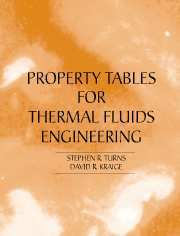Description
Properties Tables Booklet for Thermal Fluids Engineering
Authors: Turns Stephen , Kraige David
The tables in the booklet are an ideal complement to a thermodynamics textbook.
Language: English
Subject for Properties Tables Booklet for Thermal Fluids Engineering:
Approximative price 27.70 €
Subject to availability at the publisher.
Add to cart
Publication date: 08-2007
230 p. · 21.6x28 cm
230 p. · 21.6x28 cm
Description
/li>Contents
/li>Biography
/li>
This booklet is an ideal supplement for any course in thermodynamics or the thermal fluid sciences and a handy reference for the practising engineer. The tables in the booklet complement and extend the property tables in the appendices to Stephen Turn's Thermodynamics: Concepts and Applications and Thermal-Fluid Sciences: An Integrated Approach. In addition to duplicating the SI tables in these books it extends the tables to cover US customary units as well. The booklet also contains property data for the refrigerant R-134a and properties of the atmosphere at high altitudes.
Part I. SI Units Appendices A-M: Appendix A. Thermodynamic properties of refrigerant-134a; Appendix B. Thermodynamic properties of ideal gases & carbon; Appendix C. Thermodynamic & thermo-physical properties of air; Appendix D. Thermodynamic properties of H2O; Appendix E. Various thermodynamic data; Appendix F. Thermo-physical properties of selected gases at 1 ATM; Appendix G. Thermo-physical properties of selected liquids; Appendix H. Thermo-physical properties of hydrocarbon fuels; Appendix I. Thermo-physical properties of selected solids; Appendix J. Radiation properties of selected materials and substances; Appendix K. Mach number relationships for compressible flow; Appendix L. Psychrometry chart 714 T; Appendix M. Properties of the atmosphere at high altitude; Part II. Appendix AE-ME English Units: Appendix AE. Thermodynamic properties of refrigerant-134a; Appendix BE. Thermodynamic properties of ideal gases & carbon; Appendix CE. Thermodynamic and thermo-physical properties of air; Appendix DE. Thermodynamic properties of H2O; Appendix EE. Various thermodynamic data; Appendix FE. Thermo-physical properties of selected gases at 1 ATM; Appendix GE. Thermo-physical properties of selected liquids; Appendix HE. Thermo-physical properties of hydrocarbon fuels; Appendix IE. Thermo-physical properties of selected solids; Appendix JE. Radiation properties of selected materials and substances; Appendix KE. MACH number relationships for compressible flow; Appendix LE. Psychrometry chart 715 T; Appendix ME. Properties of the atmosphere at high altitude.
Stephen R. Turns has been a Professor of Mechanical Engineering at The Pennsylvania State University since completing his Ph.D. at the University of Wisconsin in 1979. Before that, Steve spent five years in the Engine Research Department of General Motors Research Laboratories in Warren, Michigan. His active research interests include the study of pollutant formation and control in combustion systems, combustion engines, combustion instrumentation, slurry fuel combustion, energy conversion, and energy policy. He has published numerous refereed journal articles on many of these topics. Steve is a member of the ASME and many other professional organizations and has been an ABET Program Evaluator since 1994. He is also a dedicated teacher, for which he has won numerous awards, including the Penn State Teaching and Learning Consortium, Hall of Fame Faculty Award; Penn State's Milton S. Eisenhower Award for Distinguished Teaching; the Premier Teaching Award, Penn State Engineering Society; and the Outstanding Teaching Award, Penn State Engineering Society. Steve's talent as a teacher is also reflected in his bestselling advanced undergraduate textbook Introduction to Combustion: Concepts and Applications, 2nd edition. Steve's commitment to students and teaching is shown in the innovative approach and design of Thermal-Fluid Sciences: An Integrated Approach and its companion volume Thermodynamics, also published by Cambridge University Press.
David R. Kraige is a Senior Mechanical Engineer at KCF Technologies. He graduated from Pennsylvania State University with a Masters in Mechanical Engineering in the Spring of 2007.
David R. Kraige is a Senior Mechanical Engineer at KCF Technologies. He graduated from Pennsylvania State University with a Masters in Mechanical Engineering in the Spring of 2007.
© 2024 LAVOISIER S.A.S.




